What is a resilient road?
Resilience is about getting through
A resilient road is increased by managing risks and long-term resilience challenges and helping communities quickly recover from disruptions. People, whānau and businesses still need to get to where they’re going, so we want our roads to be able to withstand disruptive events.
A resilient road can perform effectively and adapt to changing conditions (including climate change) and recover quickly from disturbances.
Threats to resilience
Because of the geological terrain of some parts of the country threats to resilience include:
Overslips/landslides
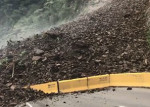 The soil and soft rocks on the coast don’t need much rain to cause a slip, also called a landslide. An overslip is when material comes down onto the road from a bank or hill.
The soil and soft rocks on the coast don’t need much rain to cause a slip, also called a landslide. An overslip is when material comes down onto the road from a bank or hill.
Underslips/dropouts
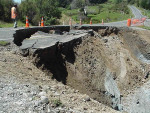 Underslips occur on the downhill side of the road. They don’t always directly affect the road’s surface but pose a risk if unaddressed. When a section of the road’s surface and foundation has dropped away either from an underslip or other erosion, we call this a dropout.
Underslips occur on the downhill side of the road. They don’t always directly affect the road’s surface but pose a risk if unaddressed. When a section of the road’s surface and foundation has dropped away either from an underslip or other erosion, we call this a dropout.
These issues usually occur in hill country with weak geology, or in areas near the coast or rivers. They often happen suddenly during a storm event, though there are some known sites that we continue to monitor.
Subsidence
 When the surface of the ground sinks it’s called subsidence. Sometimes we can’t see that subsidence is happening until it has already created a hazard on the road. Causes include too much water in the ground and weak underlying soil and rock. Subsidence is a major problem in this region.
When the surface of the ground sinks it’s called subsidence. Sometimes we can’t see that subsidence is happening until it has already created a hazard on the road. Causes include too much water in the ground and weak underlying soil and rock. Subsidence is a major problem in this region.
Flooding
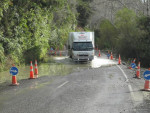 Flooding occurs when water cannot drain away and spills on to the road. Heavy rain, blocked drains, steep banks, and limited vegetation can contribute to the effects of flooding.
Flooding occurs when water cannot drain away and spills on to the road. Heavy rain, blocked drains, steep banks, and limited vegetation can contribute to the effects of flooding.
Treatments to improve resilience
Soil stabilisation
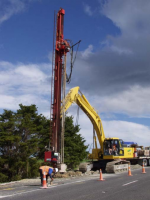 A method already used on the East Coast to treat subsidence sites is called Colmix. This involves using a specialised drill rig to mix a small amount of lime and cement into the soil to create a solid column, which improves the strength of the soil. Steel shafts can also sometimes be used to achieve the same goal.
A method already used on the East Coast to treat subsidence sites is called Colmix. This involves using a specialised drill rig to mix a small amount of lime and cement into the soil to create a solid column, which improves the strength of the soil. Steel shafts can also sometimes be used to achieve the same goal.
Drainage improvements
 Soft rock and soil like we have on the East Coast can absorb a large amount of water and become unstable. By reducing the amount of water reaching the ground and removing water from under the surface, we can improve soil strength so that both overslips and subsidence become less likely.
Soft rock and soil like we have on the East Coast can absorb a large amount of water and become unstable. By reducing the amount of water reaching the ground and removing water from under the surface, we can improve soil strength so that both overslips and subsidence become less likely.
Retaining walls
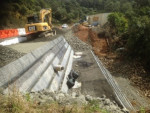 Where a reasonable foundation under the soil exists, a retaining wall can be used to reform an area of road. Retaining walls can be made from various materials: commonly iron or wooden posts and wooden boards, mass blocks of concrete or rocks, or baskets with rock fill inside.
Where a reasonable foundation under the soil exists, a retaining wall can be used to reform an area of road. Retaining walls can be made from various materials: commonly iron or wooden posts and wooden boards, mass blocks of concrete or rocks, or baskets with rock fill inside.
Retreats
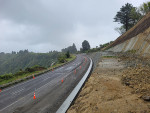 Sometimes the best thing to do is relocate the road away from the issue. This could include moving the road onto more stable ground or away from a river.
Sometimes the best thing to do is relocate the road away from the issue. This could include moving the road onto more stable ground or away from a river.
Rock protection
 Rock protection (known as a rock revetment) is a rock barrier to protect against erosion. Where erosion is occurring, a revetment can remedy the situation by placing fill at the site and then building a thick layer of large rocks to absorb the wave or river energy.
Rock protection (known as a rock revetment) is a rock barrier to protect against erosion. Where erosion is occurring, a revetment can remedy the situation by placing fill at the site and then building a thick layer of large rocks to absorb the wave or river energy.
Site monitoring
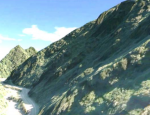 There are several site monitoring techniques that can be used such as camera and drone surveillance to monitor slopes. More recent technologies include sensors and comparison of 3D ground surface models generated from drones.
There are several site monitoring techniques that can be used such as camera and drone surveillance to monitor slopes. More recent technologies include sensors and comparison of 3D ground surface models generated from drones.
Rockfall fence
 Low rock fall fences are effective for holding back small quantities of rock and are easy to maintain. Both upgrading the existing rockfall fences and installing new fences have been proposed for several of the identified clusters through the Waioeka Gorge.
Low rock fall fences are effective for holding back small quantities of rock and are easy to maintain. Both upgrading the existing rockfall fences and installing new fences have been proposed for several of the identified clusters through the Waioeka Gorge.
Mesh fence and anchors
 A mesh system (or slope retention system) consists of nets anchored to the slope to secure and retain the material in place.
A mesh system (or slope retention system) consists of nets anchored to the slope to secure and retain the material in place.
Groynes
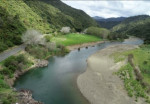 A groyne is a physical barrier that intercepts sediment that would otherwise erode a particular area. It is used to ‘river train’ and deflect flowing water away from high erosion-risk zones.
A groyne is a physical barrier that intercepts sediment that would otherwise erode a particular area. It is used to ‘river train’ and deflect flowing water away from high erosion-risk zones.
Gabion walls
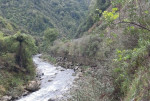 A gabion wall is a cage or box filled with rocks, concrete or sand and soil used for erosion control. They can be used between the river and the road to prevent underslips.
A gabion wall is a cage or box filled with rocks, concrete or sand and soil used for erosion control. They can be used between the river and the road to prevent underslips.
Safety and access
 Curve advisory speed limits assist safer driving by indicating the maximum speed at which a curve may be comfortably driven under good road and weather conditions.
Curve advisory speed limits assist safer driving by indicating the maximum speed at which a curve may be comfortably driven under good road and weather conditions.
 Pull-off areas allow motorists to turn around safely and proceed in the opposite direction. These are necessary when drivers are asked to turn around because of a road closure.
Pull-off areas allow motorists to turn around safely and proceed in the opposite direction. These are necessary when drivers are asked to turn around because of a road closure.
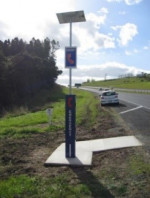 Emergency phones found along state highways are used primarily for emergencies, particularly where there is limited cell reception. These are integrated into the existing highway emergency/information hotline managed by the National Traffic Operations Centre.
Emergency phones found along state highways are used primarily for emergencies, particularly where there is limited cell reception. These are integrated into the existing highway emergency/information hotline managed by the National Traffic Operations Centre.
 Rescue helicopter landing areas provide emergency services with greater access to remote areas, which means injured people requiring medical assistance will be able to get treatment as quickly as possible. Landing pads are clearly marked with a large yellow 'H'.
Rescue helicopter landing areas provide emergency services with greater access to remote areas, which means injured people requiring medical assistance will be able to get treatment as quickly as possible. Landing pads are clearly marked with a large yellow 'H'.